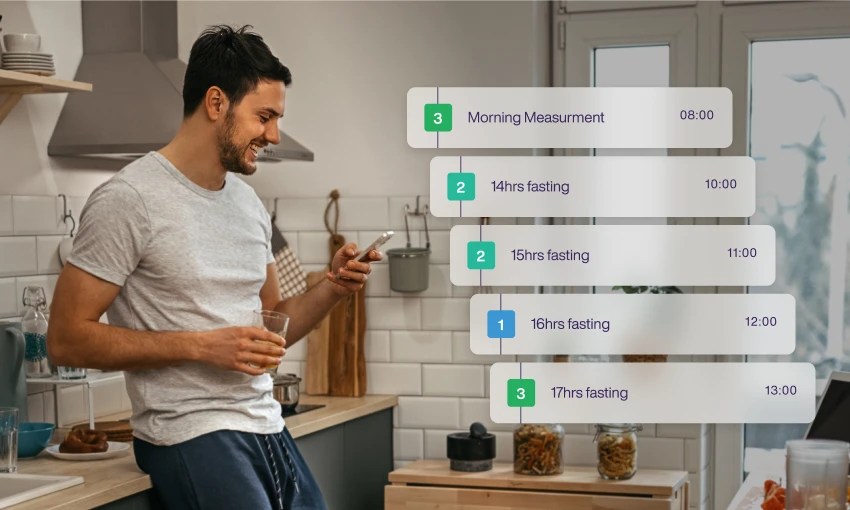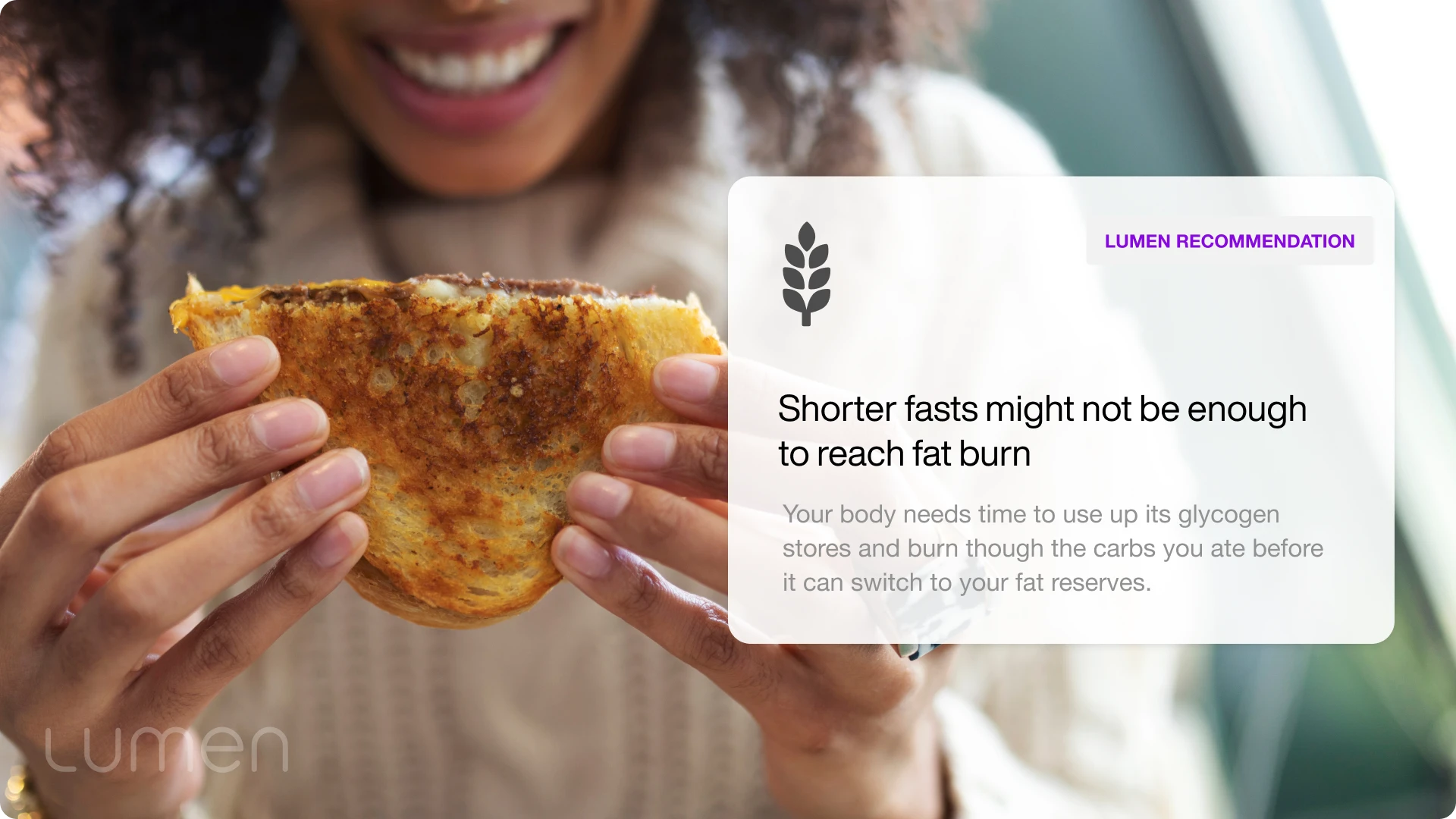Is the 16:8 Intermittent Fasting Window Right For You?


16:8 Intermittent Fasting (IF) has been hailed by many as the secret sauce to optimal health. But is it right for everyone?
With so many fasting schedules and methods, selecting the right one for your body might be tricky. Fasting for too many hours can trigger a counteractive stress response in the body, which results in carb burn rather than fat burn. If you fast for too few hours, you don’t give your body enough time to burn through the carbs, which leads to stored fat. This is not the best news, considering we want to wake up in fat burn most of the time.
Fasting affects different people differently, and some will benefit from it more than others.
We get it. Choosing the right fasting schedule can be challenging due to the variety available. In this article, we’ll explore the 16:8 approach and use evidence-based insights, including findings from Lumen, in getting the perspective on IF, its potential benefits, and the significance of personalization.
Fasting, a practice with ancient roots, has evolved in its modern-day approach and purpose. In fact, you’re probably already practicing some form of intermittent fasting while you sleep, fasting for around 12 hours due to your last meal and sleep cycles.
Today, fasting, especially intermittent fasting (IF), is recognized for its numerous health benefits, including promoting weight loss, improving metabolic functions, and potential stabilization of blood sugar levels, reducing the risk of insulin resistance and conditions like type 2 diabetes.
It differs from most diets. Instead of focusing on what to eat, it emphasizes when to eat. One of the most popular IF methods is the 16:8 fast, where one fasts for 16 hours and eats during an 8-hour window. For instance, you might choose to start your fast after dinner, say 8 pm and then fast until 12 noon the next day.
By confining your eating periods, you not only maintain flexibility in meal choices but also tend to decrease your overall caloric intake naturally. This schedule can be adopted daily or a few times a week based on individual goals and comfort.
However, while many favor the 16:8 diet, it's important to note that its success can vary among individuals due to differing metabolic responses. If you're not seeing your desired outcomes, consider adjusting your fasting duration with a fasting tracker.
Our body normally relies on a steady flow of glucose from the carbs we eat throughout the day to give us the energy to perform our normal bodily functions. Some of this glucose will be stored in the liver as glycogen to be used for energy at a later stage.
When we are fasting or going for prolonged periods without carbohydrates, our body will tap into the glycogen stores in our liver to release reserved glucose into our bloodstream for continued energy. This happens a few hours into your fast. Over time, this results in a decrease in insulin production which can help to improve overall insulin sensitivity (1).
Glycogen stores are typically depleted within 12 hours after you begin your fast your body turns to stored fat for energy. During this process, stored fat is broken down into fatty acids and glycerol, which undergo further metabolism to provide energy.
Your body will begin to shift from its preferred method of synthesizing and storing fat to mobilizing it to produce energy in place of glucose through a process known as gluconeogenesis. This is when your body’s glycogen stores deplete (“shifting into fat burn”) and it creates energy from non-glucose sources (a.k.a fats and protein) (2), ensuring a steady energy supply for vital functions.
Fat metabolism is now the main source of energy as it is converted into fatty acids and glycerol. After about 16 hours of fasting, the fatty acids are converted into ketone bodies for energy. It is possible that, if not already or not yet, depending on your metabolism, your body has entered a state of “metabolic stress”. This is when the body shifts back to a carb-burn state. To ensure a successful fast, this is the signal to break your fast. We explore further below.
Find your optimal fasting window using Lumen >>
Additionally, IF of any type is believed to help promote thermogenesis which increases energy expenditure. This means your body will burn more at rest. That, combined with the restricted timing of eating, can result in a calorie deficit that may lead to weight loss and improvements in metabolic health (2, 3).
While it sounds easy enough to avoid food for a 16-hour period, It’s not exactly that simple. Everyone is different and it’s important to tailor your IF schedule based on your goals and preference for what works best for you and your metabolism.
What makes or breaks a successful fast, is finding your optimal fasting window. This means the sweet spot between your body burning fat for fuel before switching to burning carbs and increasing cortisol levels.
To find your optimal fasting window, use breath measurements and check in on your current metabolic rate with tools like Lumen. Having access to real-time biofeedback along with a personalized nutrition plan takes the guesswork out of prioritizing your metabolic health.

Find your optimal fasting window using Lumen >>
Too often, we’re focused on fasting countdowns or trying to guess whether our body has reached a fat-burning state. Lumen helps you understand how your fasting is affecting your body in real-time.
By measuring the CO2 in your breath with the Lumen device, you will instantly know whether you’re still burning carbs or whether you’ve reached a fat-burn state. With your 16:8 fast, Lumen will be able to indicate whether your overnight fast was long enough.
Here's a simple analogy:
Think of your body as a car engine. Your last meal is like the fuel you put in before a long journey - the timing matters. Having an early dinner, or even skipping it, is akin to ensuring your car uses up its fuel efficiently, allowing it to switch to an energy-saving mode smoothly.
Lumen acts like a dashboard indicator, alerting you when your engine (body) starts feeling the strain. By checking your "dashboard" (taking fasting measurements) for several hours after waking up, you can gauge how your engine is faring and whether you've hit that optimal cruising speed (fat-burn state) or if you've gone off track (carb-burn state).
Find your optimal fasting window using Lumen >>
After adopting a regimen that includes consistent fasting, tweaking the timing of your evening carb intake, engaging in carb cycling, and optimizing workouts to expedite the depletion of stored glycogen, you'll likely witness a progression in your carb-burn to fat-burn. For example, if you end your meal at 20:00 with a reading suggesting you're mainly metabolizing carbs by morning, the reading might lean towards fat metabolism - ultimately experiencing the benefits of metabolic flexibility!
While the 16:8 IF method has been shown to provide some pretty impressive benefits, It’s not the only thing you should consider. There are other key elements involved in our metabolic health that can amplify your results, including diet and exercise habits, sleep quality, and mental health.
In fact, IF may play a role in these areas as well. For example, intermittent fasting can promote sleep by lowering insulin levels and increasing melatonin production. Melatonin, the body's primary sleep-regulating hormone, helps you fall asleep quicker and enjoy uninterrupted sleep (4).
Additionally, fueling with a proper diet can help to boost athletic performance and encourage further metabolic improvements. These four pillars also work synergistically. A healthy diet helps aid exercise benefits, while exercise helps to boost mental health and improve sleep.
To get the most out of IF, these areas must be considered. While it can seem overwhelming, having a place to track them all can make life easier. With the Lumen app, you get daily personalized nutrition recommendations, along with habit tracking and real-time biofeedback.
Remember, every body adapts differently to food routines. Avoid wasting your time trying to fit into someone else’s program (5). A Lumen study found that the Lumen device could detect changes in metabolic fuel utilization as accurately as a laboratory test, providing the ability for real-time metabolic information for users under any circumstances.
To get the most out of IF, our Lumen metabolic coaches recommend:
Can I eat whatever I want during IF?
During IF the focus is on your eating and fasting schedule versus the types of foods you choose however, that does not mean you shouldn’t be paying attention to your diet during this time.
It’s important still to choose a balanced diet rich in fruits and vegetables to get the most out of IF. Consuming a diet rich in highly processed foods and added sugars can still be negatively impactful on your metabolic health even if you are staying in line with your fasting schedule.
Is it ok to drink liquids during my fast?
It is okay to consume non-caloric beverages during your fasting times such as water, black coffee, and unsweetened teas. Anything that evokes an insulin response is considered breaking the fast so it’s important to avoid adding sugar or milk to your drinks or consuming any caloric beverages such as sodas, protein shakes, smoothies, etc. during this time.
Can I workout while fasting?
It is safe for most individuals to workout fasted. In fact, some research supports fasted workouts for increased fat burn and weight loss [9].
Can I take supplements during my fast?
You can take some supplements while fasted depending on the supplement. You may wish to avoid taking products that contain high amounts of vitamins and minerals on an empty stomach as this may result in nausea. Additionally, products with fat-soluble vitamins may not be absorbed as well on an empty stomach.
Choose supplements that don’t provide any significant dose of calories. For example, a BCAA supplement is ok to take but a whey protein powder may break your fast.
Traditional diets don’t work most of the time because they don’t take metabolic health into consideration. Swap out your traditional diet for the 16:8 IF method and start taking steps to optimize your metabolism and burn fat more efficiently.
While IF has been associated with many benefits including fat loss, improvements in insulin sensitivity, and potential weight loss, it works best when combined with a healthy diet and exercise routine that also considers sleep quality and mental health. These pillars are essential factors in your metabolic health and fasting success.
While this may seem like a lot, utilizing tools such as the Lumen device can help to provide real-time biofeedback along with personalized recommendations for nutrition, habit tracking, and more to ensure your success. Learn more about Lumen and how this tiny device can help you meet your goals with ease.
Wang Y, Wu R. The Effect of Fasting on Human Metabolism and Psychological Health. Dis Markers. 2022 Jan 5;2022:5653739. doi: 10.1155/2022/5653739. PMID: 35035610; PMCID: PMC8754590.
Longo VD, Mattson MP. Fasting: molecular mechanisms and clinical applications. Cell Metab. 2014 Feb 4;19(2):181-92. doi: 10.1016/j.cmet.2013.12.008. Epub 2014 Jan 16. PMID: 24440038; PMCID: PMC3946160.
Peschke E, Bähr I, Mühlbauer E. Melatonin and pancreatic islets: interrelationships between melatonin, insulin and glucagon. Int J Mol Sci. 2013 Mar 27;14(4):6981-7015. doi: 10.3390/ijms14046981. PMID: 23535335; PMCID: PMC3645673.

Marine is a registered dietitian with a passion for well-being, health and metabolism. She started her career as a clinical dietitian, opened her private practice to accompany patients from various backgrounds in their health journey, and is now providing nutrition support for Lumen’s customers.